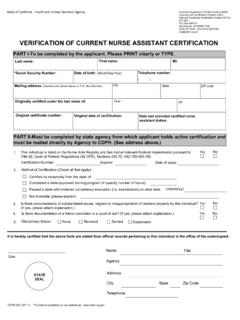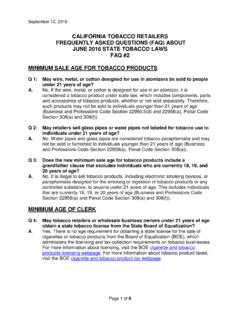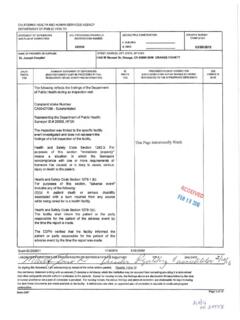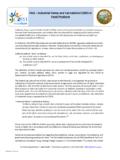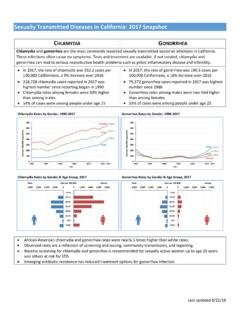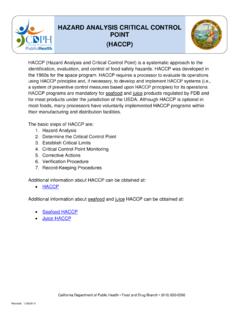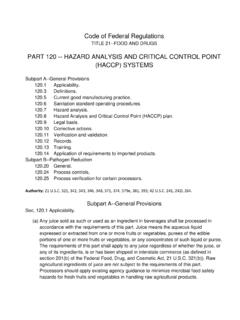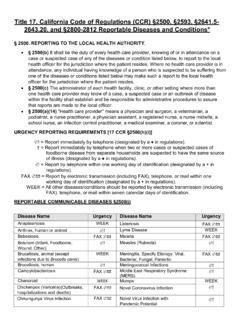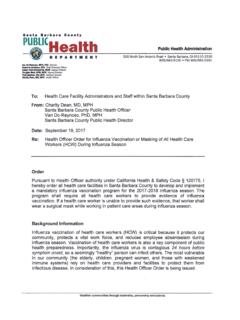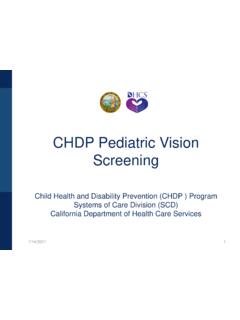Transcription of The California Prenatal Screening Program
1 The California Prenatal Screening Program is voluntary. Women can refuse testing without losing insurance benefi ts or eligibility or services from State Programs. California law prohibits the use of test results by insurance companies or employers to discriminate against an individual. If you believe that you have experienced discrimination as a result of Prenatal Screening , write to Chief of the Genetic Disease Screening Program , at the address below. California Department of Public Health Genetic Disease Screening Program 850 Marina Bay Parkway, F175 Richmond, CA 94804 866-718-7915 toll free For more information visit our website: or email us: March 2017 The California Prenatal Screening Program Table of Contents The California Prenatal Screening 2 Blood Tests are Part of Prenatal Screening The California newborn Screening Back Cover.
2 3 Three Types of Screening 4 Summary of Prenatal Screening 5 The Types of Screening 6 Test Results and Follow-Up 7 Birth 9 Diagnostic Tests Instead of Screening 11 Program 12 Consent and Patient Consent/Decline 14 Environmental Health 18 Information About Cord Blood Notice of Information and Privacy 21 The California Prenatal Screening Program Checking a Baby s Health Before Birth During pregnancy, it is important to know as much as possible about the health of the developing baby. For some women, this means testing for birth defects. Babies can be born with birth defects even when the mother is healthy.
3 The California Prenatal Screening Program can help detect some birth defects such as: Down cause of intellectual disability Trisomy disability and severe physical birth defects Trisomy disability and severe physical birth defects Neural tube as spina bifida (open spine) Abdominal wall baby s intestines are outside the body Smith-Lemli-Opitz syndrome ..SLOS is a very rare condition causing intellectual disability and physical birth defects A Screening test estimates the chance (risk) that the baby has certain birth defects. This is called a Risk Assessment . If the risk is high, a woman may then choose to have advanced Screening or diagnostic tests that confirm or rule out most birth defects.
4 See pages 9 -10 for a description of these birth defects REMEMBER, it is a woman's decision whether to have Prenatal Screening tests. A Consent or Decline form is on pages 14-17. 2 Blood Tests are Part of Prenatal Screening A small amount of blood is taken from the pregnant woman s arm and sent to the Program . At different times during pregnancy, her blood is tested for substances such as: PAPP-A ..Pregnancy Associated Plasma Protein A Chorionic Gonadotropin AFP ..Alpha-Fetoprotein uE3 ..Unconjugated Estriol Inhibin-A (DIA) These substances are made by the pregnant woman and her unborn baby. At each week of pregnancy, there are different expected amounts of these substances in the mother s blood.
5 Other information used for the Screening test includes age, race and weight. Blood test results are sent to a woman's doctor or clinic 7 to 10 days after blood draw. Based on her week of pregnancy, a woman and her doctor can choose which type of Screening is best for her. Screening Timeline First Trimester Second Trimester Blood Draw Blood Draw ..9 10 11 12 13 14 15 16 17 18 19 20 ..40 weeks Nuchal Translucency Gestation in Weeks The California Prenatal Screening Program Offers Three Types of Screening Tests Quad Marker Screening A first trimester blood specimen is drawn at 10 weeks 0 days 13 weeks 6 days of pregnancy.
6 A second trimester blood test is drawn at 15 weeks 20 weeks. The results of the two blood tests are combined. Risk assessment is reported, only in the second trimester, for Down syndrome, Trisomy 18, neural tube defects and SLOS. Sequential Integrated Screening First Trimester Risk Assessment A fi rst trimester blood specimen is drawn at 10 weeks 0 days 13 weeks 6 days of pregnancy. A Nuchal Translucency*(NT) ultrasound is done between 11 weeks 2 days and 14 weeks 2 days of pregnancy. A preliminary risk assessment is provided for Down syndrome and Trisomy 18. Second Trimester Risk Assessment A second trimester blood specimen is drawn at 15 weeks 0 days 20 weeks 0 days of pregnancy.
7 These test results are combined with the first trimester test results and NT ultrasound. New risk assessment is provided for Down syndrome and Trisomy 18. Risk assessment is also provided for neural tube defects and SLOS. Serum Integrated Screening (No NT ultrasound) One blood specimen is drawn at 15 weeks 20 weeks of pregnancy (second trimester). Risk assessment is reported in the second trimester for Down syndrome, Trisomy 18, neural tube defects and SLOS. *Nuchal Translucency (NT) - A type of ultrasound done only by doctors or technicians with special training. It measures the fluid at the back of the baby's neck. All babies have a collection of fluid, but babies with Down syndrome and Trisomy 18 tend to have more.
8 You should talk to your doctor about where to go for Nuchal Translucency Ultrasound. Also talk to your insurance about coverage. This special ultrasound is not provided by the Prenatal Screening Program . 4 Comparing The Three Types of Prenatal Screening Tests Name of Screening Test Test Type When the Test is Done Detection Rates Sequential Integrated Screening Two Blood Draws + Nuchal Translucency Ultrasound First blood draw between 10 weeks to 13 weeks 6 days of pregnancy. Nuchal Translucency ultrasound 11 weeks 2 days to 14 weeks 2 days Second blood draw between 15 to 20 weeks of pregnancy. 90 out of 100 Down syndrome 81 out of 100 Trisomy 18 97 out of 100 anencephaly 80 out of 100 open spina bifi da 85 out of 100 abdominal wall defects 60 out of 100 SLOS Serum Integrated Screening Two Blood Draws First blood draw between 10 weeks to 13 weeks 6 days of pregnancy.
9 Second blood draw between 15 to 20 weeks of pregnancy. 85 out of 100 Down syndrome 79 out of 100 Trisomy 18 97 out of 100 anencephaly 80 out of 100 open spina bifi da 85 out of 100 abdominal wall defects 60 out of 100 SLOS Quad Marker Screening One Blood Draw Between 15 to 20 weeks of pregnancy 80 out of 100 Down syndrome 67 out of 100 Trisomy 18 97 out of 100 anencephaly 80 out of 100 open spina bifi da 85 out of 100 abdominal wall defects 60 out of 100 SLOS Based on your week of pregnancy, you and your doctor can choose which type of Screening is best for you The Types of Screening Results Your results are specific to you and your current pregnancy.
10 Result: Preliminary Risk Assessment - This first trimester result means that the risk (chance) of the baby having Down syndrome or Trisomy 18 is low enough that the Program does not offer follow-up tests. Result: Screen Negative - This second trimester result means that the risk (chance) of the baby having any of the screened birth defects is low enough that the Program does not offer follow-up tests. Important: A result of Screen Negative or Preliminary Risk Assessment does not guarantee that there are no birth defects. Prenatal Screening tests cannot detect 100% of these birth defects. See Chart on page 5 to compare detection rates of the three types of Prenatal Screening tests.

